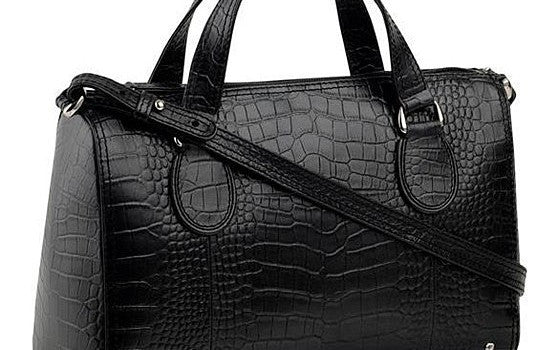
Article Detail
03 Feb
A handbag is an essential component of any woman’s wardrobe. It is used for carrying a huge number of essential items, from phone to keys to a purse to a hairbrush. Most women (and men, for that matter) shop impulsively – if they see something that they like the look of, they will pick it up. This is a rather scattershot method of shopping – and one which might result in disappointment in the months after a purchase has been made.
The fact is that some handbags will suit the needs of some women and some will not. Some, on the other hand, are objectively inferior to their rivals, carrying all sorts of flaws. To make matters worse, some of these flaws aren’t immediately obvious unless you know what you’re looking for.
It is risky to simply buy a handbag and hope for the best. It is far better, rather, to know exactly which qualities you are looking for and why.
What shape should it be?
Leaving practical concerns to one side for the moment, you will want a handbag which looks good – and more specifically, one that looks good when you are carrying it. You should get one that matches your body; one that accentuates your best features while disguising those you aren’t so fond of.
There are a number of general rules to look out for. Small handbags make you look bigger, while larger ones make you look smaller. Long rectangular handbags make you look taller, while round ones make you look rounder.
Attention should also be paid to the length of the handbag’s straps. Where does it hang on your body? Handbags which terminate at your hips, for example, will draw attention to your hips. If you’d like to avert attention, then get one with shorter straps, so that it hangs higher up.
A handbag hanging in the right area will create a bit of balance. If you have a pear shaped body, a shorter bag will balance out your figure. If you have a long, rectangular body, then a handbag that hangs by your waist will make you appear curvier.
Where possible, you should elect for straps that can be adjusted. Adjustable straps will allow you to tailor the appearance of the bag on your body, making sure that you are able to position the bag at the appropriate height.

This faux-crocodile skin bag boats adjustable straps
What should I look out for in a handbag?
There are a few signs which give a strong indication of a handbag’s overall quality and allow you to distinguish between something that is going to last and something that is going to fall apart as soon as it is under duress. If you’re shopping online, you can return a handbag which falls short of the required standard.
Stitching
Just as it would be for a dress or a pair of jeans, stitching is an excellent indicator of overall quality. Be on the lookout for errant threads. The seams should also match the pattern of the bag, if there is one.
Zips
You should check to see how smoothly the zips open and close. If they glide smoothly, then you’re onto a winner. If, on the other hand they show any signs of catching, then steer clear. Keep in mind that the state of a zip will invariably deteriorate after a few months of opening and closing – the last thing you want is a stuck zip preventing you from getting into the bag!
Straps
We have already touched on the fact that the length of a strap will hugely influence the overall look of a handbag when you’re carrying it. You should also pay extra special attention to the area where the strap is joined to the handbag. It is here that the majority of the stress will be placed; if the handbag is to break, it is overwhelmingly likely that the break will occur at this point. If the strap is attached to the bag using only glue, then you should discard the handbag as it is inevitably going to fall to pieces.

The tassel on this teal bag is designed to be removed.
Simplicity
As in all things, the simplest designs are almost always the best – both in terms of elegance and longevity. The more separate parts the bag has, the more opportunities it has to break. It’s all very well having a bag with twenty different buttons, but as soon as one of those buttons decides to give up the ghost, the maximalist look you’ve gone for will be utterly ruined.
Another downside of overly complicated bags is that it will be difficult to keep track of the various compartments. If your handbag contains dozens of separate pockets, it will get confusing! Items will lose themselves forever and turn up six months later when you re-discover a pocket within a pocket. A handbag should be a convenience, not an ongoing puzzle.
Weight
Some handbags constitute a huge amount of weight before you’ve even put anything in them. If the bag is inordinately heavy, then it may cause trouble in the long run. The back pain which will result from having to haul a heavy handbag around a town centre for hours on end is deeply unpleasant. Similarly, if a bag has thin straps, it will dig into the flesh around your shoulder.
Other details
Some bags have features which seem almost space-age. Magnetically-sealing pockets, for example, make a handbag stand out from the crowd. Obviously, a bag with awful stitching and zips that stick cannot be rescued by that sort of superficial flourish, but it might just help provide the icing on the cake.
Leather handbags
All leather handbags are the same, right? Not so fast. There are many different sorts of leather employed in handbag manufacture, some of which are easy to maintain, others require that you put in a bit of work to get the best out of them.
Aniline leather bags are made from animal hide which is relatively untreated. They are coloured with a dye rather than coating of polymer and so are more vulnerable to nicks and scratches. Pigmented bags are more durable than aniline ones. They are so called because they are coated in a polymer which protects the bag, as well as lending it a bit of colour. Finally, there exists a third variety which offers a middle way; a semi-aniline bag will be coloured using both dye and a coating of polymer.
Within these three categories, there are many different sorts of leather – just as there are many different kinds of animal. Suede, for example, is only made from the more delicate inner skin of the animal and so is thin and soft.
Caring for your handbag
If the handbag is leather, it will be vulnerable to changes in temperature and humidity. This is especially true of vegetable-tanned leather, which can radically change colour in response to such changes. You should therefore take steps to protect the surface – fortunately, there are many leather protecting products designed for exactly such a purpose.
Clean it
Regular cleaning with a dry cloth will be hugely effective. It takes seconds and its effects are substantial. If you would like to use the sort of leather cleaner usually reserved for shoes, then you can do so – but be aware of those that leave a residue.
Condition it
Leather is vulnerable to drying out over time. This will seriously affect the pliability of the material, and so it is wise to take steps against it. A good leather conditioner will go a long way toward maintaining a handbag’s lustre; inferior conditioners, which are derived from mineral oils and petroleum, will leave greasy residue, and so should be avoided.
Leather should be conditioned fairly regularly – once or twice a month is generally often enough. If the leather has been exposed to extremes of temperature, then it is also wise to give it a quick once-over.
Store it somewhere safe
After a night out on the town, it is often tempting to simply dump your handbag on the living room floor. This will not do! Instead, store it somewhere cool and dry, where air is able to flow. This will help to guard against damp. A few packs of silica gel – or any other desiccant – will also help by drying out the interior of the bag. Finally, the shape of the bag may change over time, as the leather collapses in on itself – you can go a way toward maintaining a bag’s shape by stuffing it full of old newspaper. This is particularly advisable if you know you aren’t going to be using it for a long time.
 Free delivery on orders over £20
Free delivery on orders over £20






